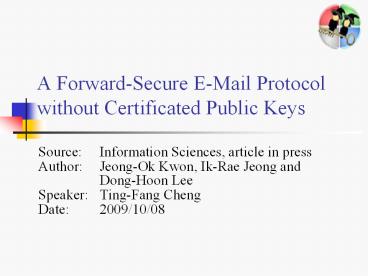A Forward-Secure E-Mail Protocol without Certificated Public Keys - PowerPoint PPT Presentation
1 / 11
Title:
A Forward-Secure E-Mail Protocol without Certificated Public Keys
Description:
Password-based e-mail protocol. Considerations of an e-mail system for mobile applications ... g1, g2: two generators of G : A's one-time private/public key pair : ... – PowerPoint PPT presentation
Number of Views:29
Avg rating:3.0/5.0
Title: A Forward-Secure E-Mail Protocol without Certificated Public Keys
1
A Forward-Secure E-Mail Protocol without
Certificated Public Keys
- Source Information Sciences, article in press
- Author Jeong-Ok Kwon, Ik-Rae Jeong and
Dong-Hoon Lee - Speaker Ting-Fang Cheng
- Date 2009/10/08
2
Introduction (1/2)
The common e-mail architecture
Mail Servers
Store-and-forward system
Sender (A)
Receiver (B)
M
M
3
Introduction (2/2)
Considerations of an e-mail system for mobile
applications
- Confidentiality and authenticity
- PGP, 1995
- Forward secrecy
- Diffie-Hellman key exchange, 1976
- Sun et al.s e-mail protocol, 2005
- Kim et al.s e-mail protocol, 2006
- Efficiency
- Password-based e-mail protocol
4
Notations
- SA the mail server which A registered
- SB the mail server which B registered
- pwA As password shared with SA
- pwB Bs password shared with SB
- G the finite cyclic group of order q
- p a large prime
- g1, g2 two generators of G
- As one-time private/public key
pair - Bs one-time private/public key
pair - Ek(.)/Dk(.) the symmetric encryption/decryption
algorithm with key k - PEk(.)/PDk(.) the public-key encryption/decryptio
n algorithm with key k - Mac(.), F(.), H(.) three pseudorandom functions
5
Proposed protocol (1/6)
The scenario
- Assume that A wants to send a message M to B
- A and B have registered at distinct mail servers
SA and SB respectively - SA stores (A, )
- SB stores (B, )
6
Proposed protocol (2/6)
Login phase of A
SA
A
Selects xA ? Zq Computes
A, XA
Selects yA ? Zq Computes
SA,
Computes
Computes
7
Proposed protocol (3/6)
Login phase of A
SA
A
Verifies Computes
Verifies Computes
Key agreement
8
Proposed protocol (4/6)
Sending phase of A
SA
SB
A
Establish a short-term key kSS through a secure
AKE protocol
Computes
YB
Decrypts YB Computes
YA
9
Proposed protocol (5/6)
Sending phase of A
SA
SB
A
YA
Decrypts YA to get Computes
Z1
Decrypts Z1 to get Z Computes
Z2
Decrypts Z2 Stores (A, B, Z) in database
10
Proposed protocol (6/6)
Receiving phase of B
B
SB
B login to SB and produces a key KB shared with SB
Searches database Computes
Computes Chooses new public/private key pair
to replace the old one in its
mobile device
Decrypts the message to get Replaces
with
11
Conclusions
- Forward secrecy
- Password-based protocol
- Practicality and efficiency































